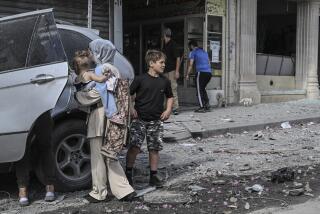Japanese Mayors Call A-Bomb Attacks a Crime
- Share via
TOKYO — Underscoring a wide “perception gap” between Japan and the United States, the mayors of Hiroshima and Nagasaki on Wednesday sharply challenged the prevailing U.S. view that the nuclear attacks on their cities were necessary to end World War II.
Nagasaki Mayor Hitoshi Motoshima called the attacks “one of two great crimes against humanity in the 20th Century, along with the Holocaust.”
Although he conceded that the attacks helped hasten the war’s end--a concession Hiroshima Mayor Takashi Hiraoka refused to make--he questioned the price.
“Does avoiding the death of servicemen justify the sacrifice of tens of thousands of guiltless noncombatants?” Motoshima asked, pointing out that the bombs indiscriminately killed men, women and children. “This is tantamount to killing a flea with a sledgehammer. It can hardly be called a justified act, even in wartime.”
The bombs, dropped in August, 1945, killed and injured 130,000 people in Hiroshima--almost half the city’s population--and 74,000 in Nagasaki. Hundreds of thousands of survivors suffered cancer and other radiation aftereffects.
The mayors, in a joint appearance before foreign correspondents, argued that the United States dropped the bombs mainly to intimidate the Soviet Union, verify the weapons’ effectiveness and justify the $2 billion spent to develop them.
But U.S. officials and veterans groups have long insisted that the bombs were dropped mainly to hasten the war’s end and save more than 1 million Allied lives that might have been lost if the Allies had been forced to wage land operations in Japan.
“Our perception was that the tragedy of Hiroshima and Nagasaki was the advent of the Nuclear Age,” Hiraoka said, “but the U.S. perceived the bombing as the end of World War II. This perception gap lay at the root of the debate.”
Both mayors stressed that their intent was not to criticize Americans or portray the Japanese as innocent war victims but to appeal for the abolition of nuclear arms.
“What I want to emphasize and appeal here is that the people of the world should not avert their eyes from what happened in Hiroshima and Nagasaki and understand the horror of nuclear weapons,” Hiraoka said. “At the same time, I’d like to reflect on the atrocities that Japan committed during World War II.”
The two mayors also expressed sharp disappointment that political pressure forced the Smithsonian Institution in Washington to drastically revise a planned exhibition on the Enola Gay bomber and the nuclear attacks.
The museum originally intended to include photographs and other mementos from Hiroshima and Nagasaki to show the consequences of the attacks--the ghastly deaths and lingering aftereffects of radiation.
But the museum nixed that plan after veterans groups and others furiously protested that it wrongly portrayed the Japanese as blameless victims and failed to show the attacks’ context--Japan’s military aggression.
“It is extremely disappointing to me that the perspective of humanity has been lost from the altered Smithsonian exhibition,” Hiraoka said. He plans to visit the United States later this year to show the public the photographs and other mementos that the Smithsonian has withdrawn from its exhibit.
Nagasaki’s Motoshima began his address with an apology to those who suffered under Japan’s attack on Pearl Harbor and its invasions in Asia during the Pacific War.
The Catholic mayor is one of Japan’s most outspoken political leaders on that nation’s legacy of military aggression and has paid dearly for it: He was shot and almost killed in 1990 by a right-wing terrorist after he said the emperor bore some responsibility for the war. He also was dumped by the leading Liberal Democratic Party, or LDP, for that statement but was successfully reelected with other party support.
Motoshima has also called for payments to Korean residents who were victims of the atomic bombs and for public education--through museums and schools--on Japan’s military aggression and wartime atrocities. Such education is virtually absent in Japan because conservative members of the LDP, veterans associations and right-wing groups argue that the war was not an act of aggression but a defensive gesture to break a crippling U.S. embargo against Japan and to liberate Asia from white, colonial nations.
In Hiroshima, the Peace Memorial Museum unveiled a new wing last year that cautiously began to present a picture of Japan’s own war responsibility for the first time.
Among the exhibits are photos of Korean and Chinese laborers enslaved by Japan during the war and of Hiroshima factories and shipyards that helped drive the Imperial Army’s war machine.
Motoshima has also ordered his staff to add displays in the Nagasaki Atomic Bomb Museum on the Pearl Harbor attack and Japan’s expansion in Asia.
But both mayors ducked questions on whether Japan will ever fully come to grips with its war deeds, given the realities of its conservative political climate. They urged citizens in both nations to resolve resentment and work together to eliminate nuclear arms.
More to Read
Sign up for Essential California
The most important California stories and recommendations in your inbox every morning.
You may occasionally receive promotional content from the Los Angeles Times.














